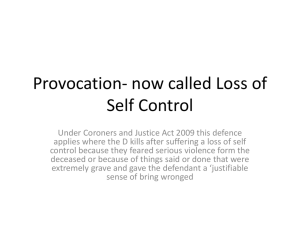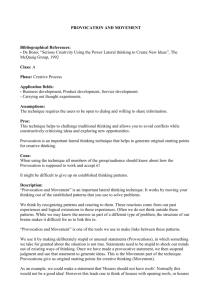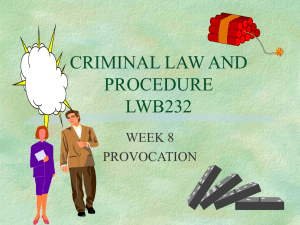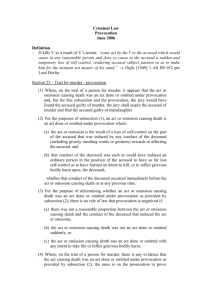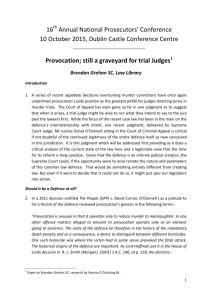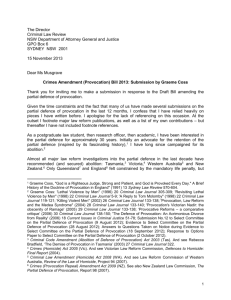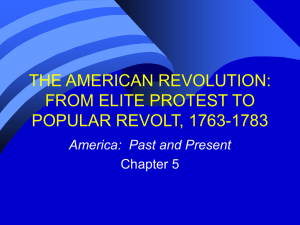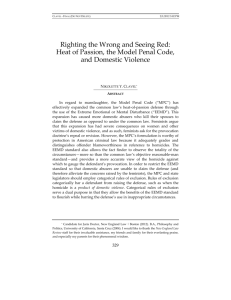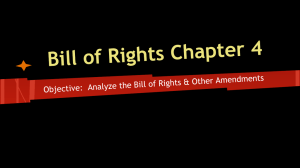Criminal Law 1
advertisement
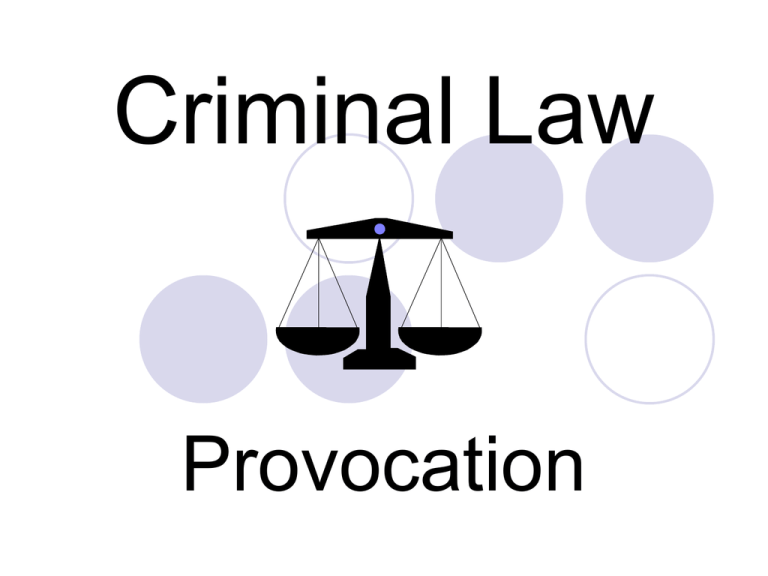
Criminal Law Provocation Provocation Violence often involves words or actions by the victim which contribute or precipitate offence sometimes force is regarded as justified Defence of self defence may apply sometimes unnecessary or disproportionate defence of self-defence does not apply Provocation At common law, conduct of the victim: irrelevant in non-fatal offences a factor that goes to mitigation of sentence but in some circumstances, defence to murder: only to murder – not to conspiracy to murder, attempted murder only partial defence – D not guilty of murder but convicted of manslaughter instead Provocation at common law At common law – Duffy 1949: Provocation is some act..done by the dead man to the accused which would cause in any reasonable person, and actually causes in the accused, a sudden and temporary loss of selfcontrol conduct of the victim had to be capable of constituting provocation words alone could not constitute provocation - Holmes 1946 Provocation: under statute Now statutory under s.3 Homicide Act 1957: Where on a charge of murder there is evidence on which the jury can find that the person charged was provoked (whether by things done or by things said or by both together) to lose his self-control, the question whether the provocation was enough to make a reasonable man do as he did shall be left to be determined by the jury; and in determining that question the jury shall take into account everything both done and said according to the effect which, in their opinion, it would have on a reasonable man. if any conduct of the victim capable of constituting provocation, must be left to jury - Doughty 1986; procedurally accused must advance some evidence of provocation for the jury to consider but does not have to ‘prove’ provocation; prosecution must disprove it - Acott 1997 Section 3 abolishes Holmes rule - things done or things said can constitute provocation Provocation: structure of defence Basis of defence is twofold: subjective ‘sudden and temporary’ loss of self control which makes D not the master of their own mind. objective evaluative test - how would a reasonable person have reacted if faced with such provocation? Provocation: loss of control ‘sudden and temporary’ loss of self control: does not mean total loss of control - D might still know what she is doing but is unable to restrain herself must be loss of control through anger - no ‘cooling off’ period for planning or revenge Ibrams and Gregory 1982 – waited several days before retaliating does allow for cumulative provocation – Ahluwalia 1993 - slow burn Provocation: evaluative test Evaluation: what sort of loss of self control was this? would a reasonable person have reacted in the same way? is reasonable person individualised - given relevant characteristics of the accused? Bedder 1954 reconsidered in Camplin 1978 • effect on person having powers of self control of ordinary sober person possessing characteristics of D that might affect gravity of provocation Provocation: a reasonable person What are relevant characteristics? Newell 1980 - definite and significant to make D a different person from ordinary run of mankind sufficient permanence to make them part of the accused’s character Thornton 1996 - battered wives’ syndrome Dryden 1995 - obsessive personality Humphreys 1995 - abnormal immaturity Provocation: current law View of the House of Lords: Morhall 1996 - addiction to glue sniffing. Taunted about this by V. Followed him and stabbed him to death. H. of L. ruled that where taunts directly related to their characteristic i.e. addiction, provocation can be found. This is different to loss of self-control due to drugs or drink. Morhall 1996 – guilty of manslaughter. Provocation: current law where taunts NOT related to characteristic Smith – at trial, jury told effect of depression on self-control irrelevant on appeal, House of Lords hold that jury ought to have been told that it was up to them whether to take it into account in assessing whether S’s conduct had measured up to the standard of self-control that ought reasonably to have been expected of him. • effectively abandons reasonable person test; the objective basis of s.3 is ‘eroded and its moral basis subverted’ (Lord Millett) • has HL expanded provocation in order to provide a wider defence than DR is able to provide? Provocation: reform Law Commission Report 290: ‘Partial Defences to Murder’ suggests killing will be manslaughter if: gross provocation (caused defendant to have justifiable sense of being seriously wronged) OR fear of serious violence AND person of D’s age and of ordinary tolerance and selfrestraint might, in the circumstances, have reacted in similar way excludes matters which bear only on D’s capacity for self-control excludes provocation incited by D excludes acts done in considered desire for revenge
